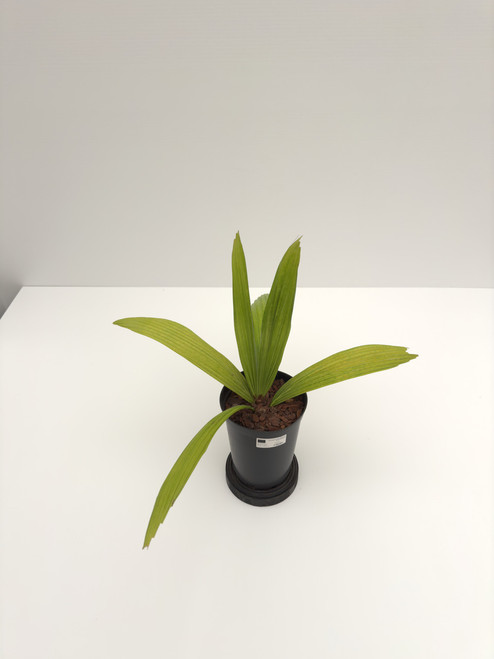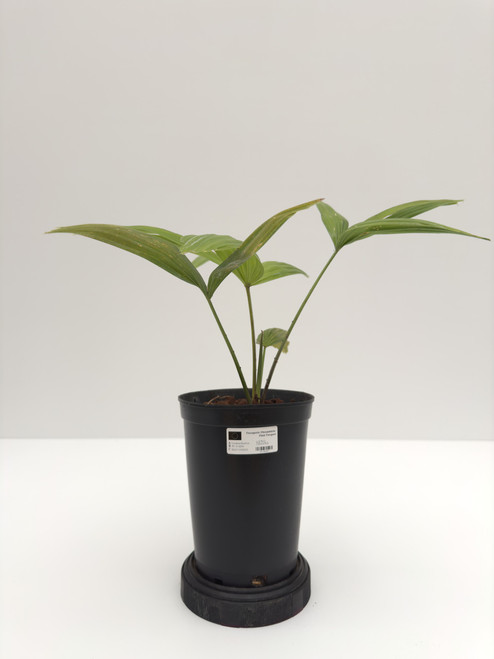Product Description
Habitat and Distribution
Saribus rotundifolia is found in Borneo, Maluku, New Guinea, and Sulawesi, Indonesia, Malaysia and the Philippines. In Indonesia on Java (though possibly escaped from cultivation only), Kalimantan, Sulawesi, Maluku, and Raja Ampat Islands; in Malaysia, in northern Sabah and nearby islands; and throughout the Philippines. Locally abundant in swampforest, seasonally dry swampforest, mangrove margins, rainforest, moist evergreen forest, along rivers and secondary forest at 0-300 m alt. Flowers all year; fruits all year. It is native to South-east Asia (Malaysia, Indonesia, Java, Moluccas, Philippines, Sulawesi, and Lesser Sunda Islands), but is now cultivated all over the world in tropical and subtropical countries as an ornamental. Mountainous pluvial forests at low and medium altitudes.
Description
Hermaphroditic palm. Trunk to 45 m tall, 15-25 cm in diam. breast high, leaf scars obscure to prominent, light green to white, internodes broad, green to grey, smooth or infrequently with longitudinal fissures, petiole stubs not persistent. Leaves 20-50 in a globose crown; petiole slightly arching, 90- 210 cm long, 15 cm wide proximally, about 2 cm wide distally, adaxially flat or moderately ridged, margins with retrorsely recurved black spines 1-20 mm long throughout or proximally only, with largest proximally, distally becoming smaller and more widely spaced, or very infrequently with spines lacking in mature plants; leaf-base fibres moderately prominent, coarse, in a criss-cross pattern, brown, persistent, appendage triangular; hastula very prominent, 2 cm high; lamina costapalmate, circular to subcircular, regularly segmented, 75-150 cm long, adaxially semi-glossy dark green, abaxially lighter subglaucescent green; lamina divided for 38-62% of its length, with 60-90 segments, depth of apical cleft 4-25% of the segment length, apical lobes usually erect, but pendulous in segments with deeper clefts; mid-leaf segments about 5 cm wide where the segments diverge; parallel veins 6-9 each side of midrib; transverse veins equal thickness or thinner than parallel veins. Inflorescences trifurcate with ± similar collateral axes, branched to 4 orders, 90-150 cm long, not extending beyond the limit of the crown, arching; partial inflorescences about 10, longest to about 30 cm; prophyll to 30 cm long, glabrous, straw coloured; peduncular bracts lacking or 1, and then tightly tubular; rachis bracts tightly tubular, reddish brown, glabrous, apically truncate, remaining intact with age; rachillae 3-20 cm long, 1-1.5 mm thick, straight, yellowish, glabrous. Flowers solitary or in clusters of 2-4, to 2-3 mm long, yellowish, sessile on small pulvini; sepals broadly ovate, very obtuse, dorsally carinate; petals less obtuse, yellowish; ovary glabrous; style subulate, acute, very short. Fruit globose to subglobose, 11-25 mm in diam., at first yellow, ripening though to orange-red to red or to dark violet or bluish-black; stigmatic remains inconspicuous; epicarp thin, smooth or with scattered lenticellular pores; suture line for full length of fruit; mesocarp about 1.5 mm thick, slightly fibrous to gritty; endocarp very thin; pedicel 2-3 mm long. Seed globose, 10-13 mm in diam., endosperm intruded for two-thirds to almost full width of endosperm; hilum broad, orbicular; embryo lateral, 2-2.4 mm long. Eophyll 5 ribbed. Editing by edric.
Culture
Saribus rotundifolia requires a shady, sheltered position when young but is quite happy in full sun when more mature and the humidity is very high. Although the Footstool Palm is from the tropics it has successfully been grown in sub-tropical and even warm temperate areas. Cold Hardiness Zone: 10a
Comments and Curiosities
In September 2011, after DNA research the reclassification from the genus Livistona to the resurrected genus Saribus was official.
Etymology: Saribus; Latin, from the Maluku vernacular name, sariboe. rotundifolia from the Latin for rotundifolius; having rounded leaves, referring to the almost round palmate leaves.
Uses: Edible Seeds and Palm Heart.
This palm was classified as Livistona rotundifolia prior to 2011.This palm is native to SE Asia where it is one of the more common landscape plants. It is not so common in the U.S. where it is mainly found in Zone 10A and higher. Under ideal growing conditions (warmth and humidity) it is one of the fastest growing palms in the world. There are reports of growth rates from seedling to 6-8 foot trunk in 3 years! It can ultimately reach heights of 80 feet or more. Young plants prefer some shade but mature ones love full sun. (pennyspalms.com)
It is a tall palm with a solitary stem, growing to about 18–27 m tall. Foliage: Its long-stalked, spirally arranged palmate leaves have leaf blades that are almost round in outline, and regularly divided to about half of the length, 1.2 m in diameter. Flowers: Its flowers are borne on a long-stalked inflorescence, about 0.9–1.2 m long. Fruits: Its round fruits are fleshy drupes that are about 2 cm across, ripening from red to black. Its flowers are pollinated by bees. Its fruits are eaten by frugivorous birds. (florafaunaweb.nparks.gov.sg)
Saribus rotundifolius (syn: Livistona rotundifolia) is a very attractive palm, especially when young, due to its large, round, shiny, shallowly divided leaves. It is also known as “Anahaw” (National leaf of the Phillipines). Trunk: Solitary, smooth, brown, with the rings of the scars of the foliar petioles in evidence and clothed with beautifully greyish woven fibres in the upper part below the crown. In its natural habitat it can grow to up to 24 metres in height but in a garden situation usually it will not grow that tall. Diameter 20-25 cm. Leaves: Broad, erect to pendent, palmate, wider than long, almost round in outline from a very early age, shiny, glossy green and incised for about half of their length in usually rigid and stiff segments. As it gets older however, the leaves become more divided, and not quite so pretty. The leaves in juvenile palms are about 1,5 metres wide and circular, while they are smaller, costapalmate in older palms and do not form a full circle. Petioles up to 2 metres, spiny at the base on lower surface in the young plants, almost unarmed in the adult specimen and blades are shorter than the petiole. Inflorescences: About 2 metres long, dividing into 3 main axis bearing up to 4 orders of branching, with small, yellow, bisexual flowers. Blooming period: Spring to summer. The flowers appear in bunches only when the plant is very old. The plants that are used as potted plants do not generally flower. Fruits: Small spherical to 1,5-2 cm in diameter red to black when ripe. (llifle.com)
Saribus rotundifolius (Lam.) Blume Arecaceae. CN: Round-leaf fountain palm, Footstool palm, Java fan palm, Serdang palm. Native range Malaysia (Sabah), Indonesia (Java, Moluccas, Sulawesi, and Lesser Sunda Islands), Philippines; elsewhere cultivated as ornamental plant. A common urban landscaping palm species in Malaysia. Solitary trunk up to about 20-25 cm of diameter; about 20 m tall.
Common Names include:
ENGLISH: Fan palm, Table palm, Serdang palm, Java fan palm, Footstool palm ARABIC ( لعربية ): ليفستونيا روتانيفولي CEBUANO (Sinugboanong Binisaya): Anahaw CENTRAL BIKOL (Bikol Central): Anahaw, Bulos CHINESE (中文): 圆叶蒲葵, Gao bei pu kui (as Livistona altissima - Taiwan), Yuan ye pu kui FRENCH (Français): Palmier évantail de Java GERMAN (Deutsch): Waldpalme, Serdang-Schirmpalme, Livistonie, Fächer-palme ITALIAN (Italiano): Palma parasole, Serdang daun bulat NORWEGIAN (Bokmål): Dronningpalme PORTUGUESE (Português): Palmeira-leque SPANISH (Español): Palmere de hoja redonda, Palmera de escabel, Palma de escabel TAGALOG: Anahaw THAI (ภาษาไทย): Paam yawa (paam jawa), Paam chawa











